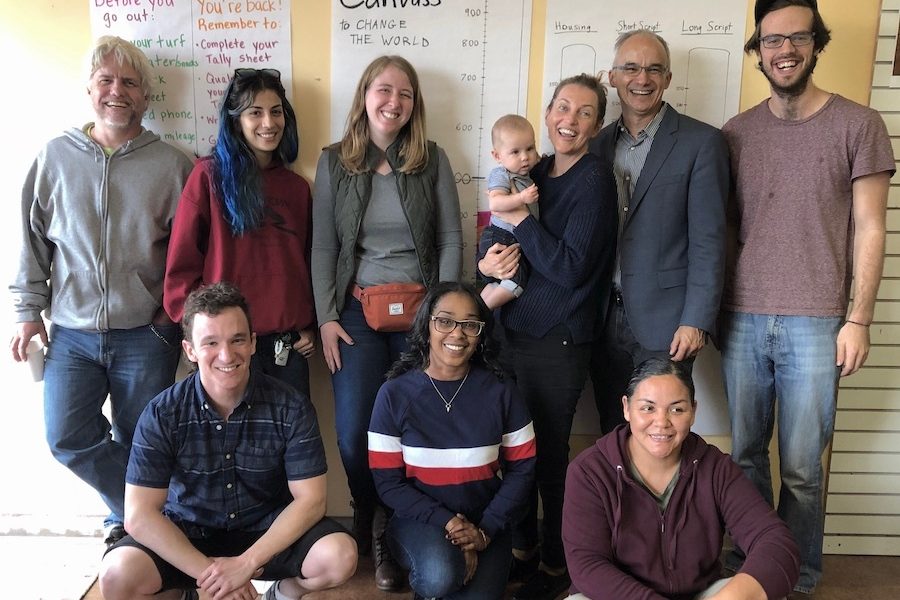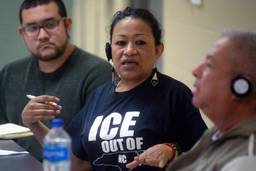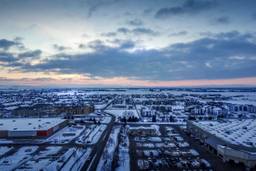‘We Get There First or White Supremacists Do’: How These Rural Canvassers Disrupt Racist Narratives
Jordan Green

Alamance County, a rural industrial county in central North Carolina, has become a flashpoint in recent years for battles over immigrant rights and Confederate monuments.
The county is more than 70% white, and Donald Trump carried it easily in 2016, winning 54.6% of the vote. Sheriff Terry Johnson — whose office was sued by the U.S. Justice Department in 2012 for racial profiling — ran unopposed in 2018 to win his fifth term. Un-chastened by years of criticism, Johnson told county commissioners during a January 2019 meeting that criminal immigrants were “raping our citizens in many, many ways,” while asking them to allocate $2.8 million in federal funds to house inmates for ICE and the U.S. Marshals Service.
In short, Alamance County might seem like an unlikely place to try to build a progressive movement for multiracial solidarity and economic justice. But the stew of punitive policies and racial demagoguery was precisely why progressive organizers deemed Alamance County a crucial battleground in the wake of the 2016 election.
While the intertwined immigration and monument battles were playing out in Alamance, canvassers from Down Home North Carolina fanned out across the county, knocking on doors and holding conversations with residents about immigration and healthcare. (When Covid-19 hit the U.S. in mid-March, canvassers shifted from door knocks to phone calls.)
The canvassers were part of a research experiment launched in the spring of 2019 in North Carolina, Pennsylvania and Michigan to test whether a tool known as “deep canvassing” could disrupt anti-immigrant narratives in rural communities and shift voters to attitudes of solidarity with immigrants. Led by Assistant Professor Joshua Kalla at Yale University and Associate Professor David Broockman at UC Berkeley, the campaign was coordinated by the national advocacy organization People’s Action and conducted on the ground by the group’s member organizations — Down Home North Carolina in the Piedmont region west of Raleigh and Durham, Michigan United in Macomb County, north of Detroit, and Pennsylvania Stand Up in the lower Susquehanna River valley, west of Philadelphia. Adam Kruggel, the director of strategic initiatives at People’s Action, said the states were chosen because all have seen an uptick in anti-immigrant sentiment and white nationalist organizing and because they will be crucial battleground states in the 2020 election.
The results of the canvassing experiment were startling: Kalla and Broockman’s research found that the canvasses shifted about eight out of 100 respondents toward supporting a government program of expanded healthcare that would include undocumented immigrants, and that the results persisted for at least four and a half months. Those who shifted their opinions included both supporters and opponents of President Trump; registered Democrats, Republicans and independents; men and women. What’s more, a new report from People’s Action indicates that approval for Trump dropped by 1.2 points among respondents polled seven weeks after the canvass, even though the initial canvass did not include any questions about Trump.
Building on those promising results, People’s Action is launching what Kruggel calls a “massive” paid and volunteer campaign across six battleground states, expanding from the three pilot states of Michigan, Pennsylvania and North Carolina to include Minnesota, Wisconsin and New Hampshire. The goal, Kruggel said, is to field at least 100 full-time, paid canvassers and 1,000 volunteers to complete 120,000 conversations across the six states before Election Day. People’s Action will also integrate deep canvassing into its campaigns in all of the 30 states where the group operates.
When the teams from North Carolina, Michigan and Pennsylvania gathered to debrief in Burlington, N.C. in December 2019, they talked about what success would look like the morning after Election Day. Electing Bernie Sanders or Elizabeth Warren as president was at the top of the list. While it’s clear that neither Sanders nor Warren will be at the top of the ballot this year, what the organizers couldn’t have predicted seven months ago is that Covid-19 and a global uprising against systemic racism would push Joe Biden to the left. And the other items on their wish list — the Democrats retaking the U.S. Senate and electing progressive candidates up and down the ballot — are looking ever more realistic.
The campaign merges deep canvassing, a technique developed about 10 years ago by Ella Barrett and Steve Deline of the New Conversation Initiative, with “the “Race-Class Narrative,” a blueprint for electoral organizing developed by law professor Ian Haney-López and communications strategist Anat Shenker-Osorio.
Deep canvassing emphasizes non-judgmentally soliciting respondents’ views and asking them to reflect on their personal experiences, while the canvasser also shares their own experiences. The Race-Class Narrative, as its name implies, insists on addressing both race and class.
“We need to specifically talk about race and class,” said Danny Timpona, an organizer with Down Home North Carolina. “The Democratic Party might talk about class or they might talk about race, but they’re not talking about both of these things and how they pull at each other. We’re specifically pointing it out. We’re naming that this is a weapon that is economically harming us, and that the alternative, the antidote, is multiracial solidarity.”
In contrast to conventional voter mobilization programs, which often rely on reductive messaging, deep canvassing allows more room for nuance and ambiguity.
“What we find with the majority of voters is they’re conflicted,” Kruggel said. “People carry all these contradictory beliefs. Often times, it’s more a matter of what is rising to the surface than a conflict in shared values. Deep canvassing helps slow people down. When you communicate, you create nonjudgmental space and lead with listening. You communicate through stories. It’s an effective way to de-polarize, to a certain extent.”
Rural areas have steadily trended more conservative and Republican over the past two decades. But since 2018 People’s Action has marked a promising shift in rural areas, with single white women and young white voters in particular moving towards the Democratic Party. And regardless of whether or not the deep canvassing campaign in the six battleground states helps defeat Trump in November, organizers argue that progressives need to make a long-term investment in rural America.
Trying to change the minds of conservative rural voters might sound like an uphill battle, but, as Down Home North Carolina campaigners are quick to point out, the alternative is far worse.
On the ground
In early December 2019, Sugelema Lynch, a former teacher, and Laura Marie Davis, another canvasser with Down Home North Carolina, set out for the Birch Bridge area, north of Burlington.
Knocking on the first door, she found an EMT with Alamance County Emergency Medical Services at home on lunch break. Mildly friendly and perhaps a little curious, he agreed to take the survey. Lynch first asked the man, who was white, to rate himself on a scale of 0 to 10 on his support for universal healthcare. He rated himself a 0.
“I don’t think we need any more government handouts,” the man said.
“Thank you for sharing that,” Lynch responded. “No, a lot of people feel the way you do. I’m a little more favorable to it.”
Unsurprisingly, the man also rated himself a 0 on universal healthcare that would include undocumented immigrants.
“I’m all for build the wall,” he said, quickly volunteering that he supports President Trump.
Lynch asked him to talk about his personal experiences with undocumented immigrants. The man said he used to own a landscaping business, and that his undocumented employees “would come on strong” but after payday they wouldn’t want to come to work because they were hung over. He also said he believes undocumented immigrants want to take advantage of government programs. But when Lynch asked for an example, he backtracked and said it wasn’t just undocumented people. He said he had worked since he was 18 years old, and people should work for what they have instead of asking for handouts.
Lynch took the opportunity to tell her own family’s story. Her parents came to the United States from Mexico as undocumented immigrants in the 1970s. She said her parents didn’t have a lot of education and most of their work experience was in agriculture. They landed in the Pacific Northwest. Since they moved every three months to follow harvests, Lynch said, her parents didn’t sign up for government assistance programs.
At the conclusion, Lynch asked the man if anything in the conversation had changed his views on either universal healthcare or universal healthcare that included undocumented immigrants. Not at all, he said.
As she walked along the gravel shoulder of the road toward the next house, Lynch reflected on the conversation.
“Sharing the humanity, maybe he’ll start thinking about undocumented immigrants differently,” she said. “I’m hoping I can make a lasting impression through telling my family’s story.”
Other respondents were already in sync with Down Home’s agenda, or proved to be persuadable.
An elderly white woman who was walking her dog to the mailbox readily agreed that universal healthcare should be extended to undocumented immigrants.
“I feel like you ought to help all that can’t help themselves,” she said.
Another neighbor, an elderly white man, told Davis that he supported universal healthcare and that he thought the government ought to make it easier for people to come to the United States legally, but said he wasn’t in favor of including undocumented immigrants in universal healthcare because, in his view, they don’t pay into the system.
Davis told the man that, in fact, undocumented people do pay taxes, even though they don’t receive Social Security.
The man re-evaluated his position.
“If they’re paying taxes, they ought to benefit,” he said.
A former school-bus driver, he and his wife had faced personal bankruptcy, he said. They had to sell their house, buy a single-wide trailer and then rent land to put the trailer on. He expressed sympathy for people who face medical-related financial challenges.
“I’m diabetic, so I’m walking on eggshells myself,” he said. “Everything is going up except my pay.”
‘Either we get there first or the white supremacists do’
Alamance County is a place where racial antagonism, historical and contemporary, is plainly visible. A month after Dylann Roof massacred nine African-American parishioners at Emanuel AME Church in Charleston, S.C., about 4,000 people rallied to defend the Confederate monument in front of the Old Alamance County Courthouse.
In October 2019, only five blocks away from that courthouse, I observed Jessica Reavis, a Virginia-based organizer with the League of the South — a group that advocates the creation of a white ethno-state in the states of the former Confederacy — stoke the grievances of a group of conservative, white bystanders jeering a march for immigrant rights. As recently as last weekend, Reavis and two other League of the South members from Virginia joined counter-protesters to respond to a Black Lives Matter protest that called for the removal of the Confederate monument.
“They can have pride in who they are, but when we are proud to be white, we’re racists and Nazis,” Reavis complained during the October 2019 standoff. “We’re trying to protect our people. We have a right to preserve our people.”
Nearby, local resident Sharon Moon echoed Reavis’ sentiments in an interview with an alt-right YouTube personality.
“The problem is that you’ve got these white folks over here that believe in white privilege, that they’re being like, white privilege! We have white privilege!” Moon said, referring to the immigrant-rights protesters. “But the truth is that Mexicans and illegal immigrants have privilege.
“Look at this,” she continued, gesturing toward a strand of yellow police tape. “We’re stuck behind here; they’re over there speaking and blocking off the streets and not being arrested. That’s privilege.”
After the protest wound down, I caught up with Moon, away from Reavis and the other hecklers, and she shared with me that a friend and co-worker had joined the immigrant-rights protesters on the other side of the police line. Sharon and her husband, David, who works in construction, also acknowledged that they had half-seriously discussed whether they should harbor the co-worker’s parents in their attic to help them evade ICE.
When I mentioned my encounter with Moon to Down Home North Carolina organizer Danny Timpona a week later, he said it was an example of both the fluidity of people’s positions on immigration and the high stakes if progressives fail to engage with rural voters.
“We believe that organizing in rural spaces with progressive, multiracial solidarity messaging is the future,” he said. “Either we get there first or white supremacists get there first.





